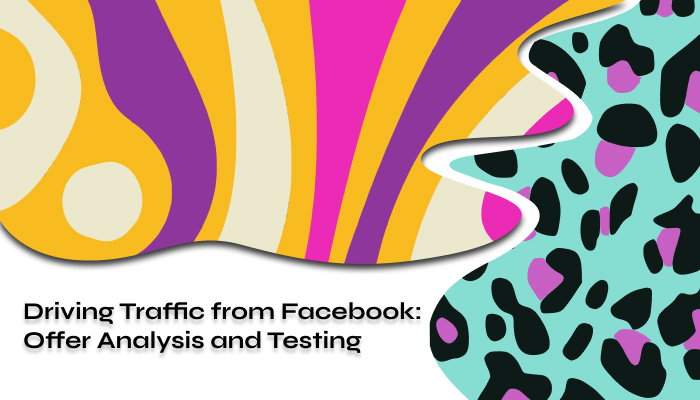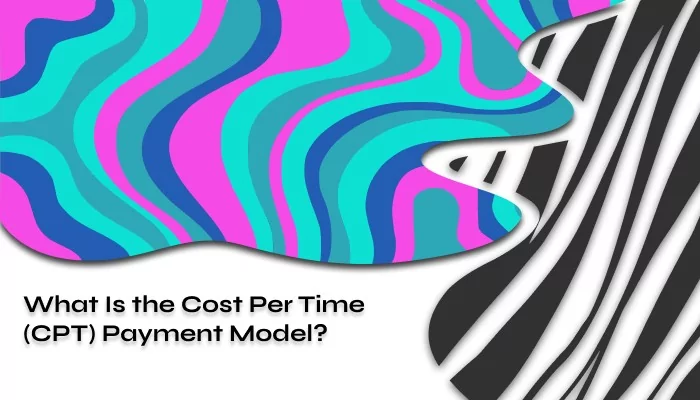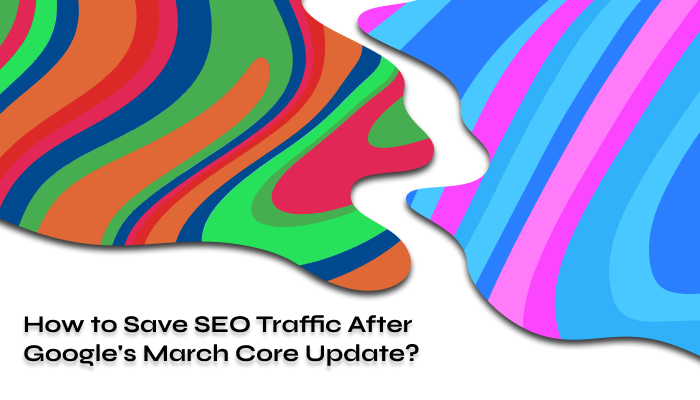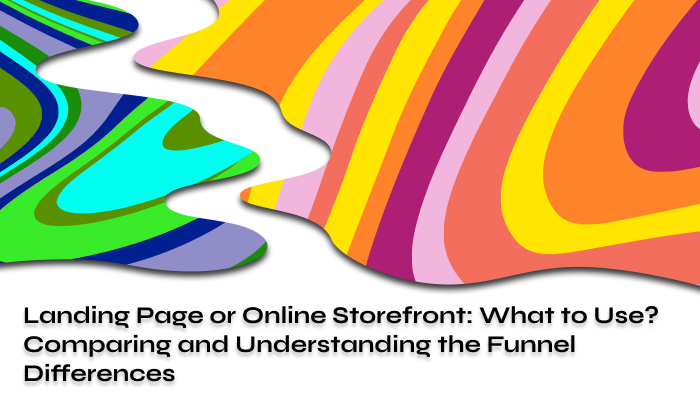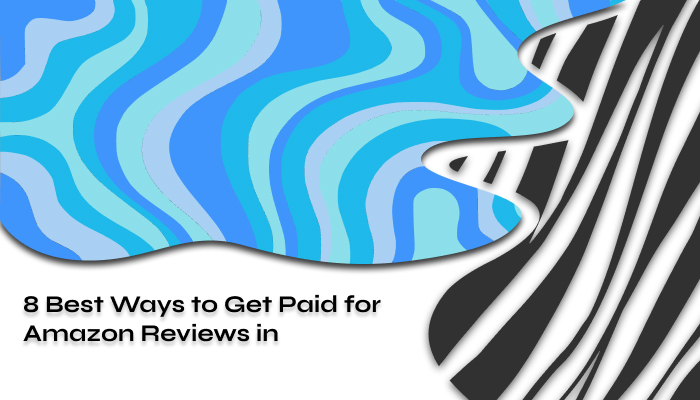We know that there are a lot of novice webmasters on our website, so today we prepared an article on some basics. Affiliate marketing has some general features regardless of verticals. Today, we will discuss audience targeting, creatives, campaign structure, and demonstrate the algorithm of how to drive traffic from Facebook to offers regardless of verticals.
But first, let’s determine what we will be promoting. Webmasters approach this task in various ways. In this test, we will cover what we consider to be the most correct approach.
How to analyze offers
At this stage, two actions need to be taken – determine the target audience of the offer and outline the main product advantages. Let’s start with the first one.

To determine the target audience (TA) of the offer, the following questions will be suitable:
- Under what circumstances will the user be interested in the promoted product? For example, if a girl is getting ready for a prom, she will need an evening dress, and if a husband doesn’t trust his wife, he might want to purchase a spy camera;
- What reasons or qualities of themselves might lead users to want this product? For instance, to impress someone, a person might be interested in replica luxury watches. Or if a girl wants to lose weight, she may decide to buy a sports suit;
- Who can be an expert for the TA, whose opinion will be considered when deciding whether to buy or not? Here it’s straightforward: for the elderly – doctors, for girls – beauty bloggers, for middle-aged people – celebrities of their generation, roughly speaking.
As for analyzing the offer itself and its key advantages, a SWOT analysis will work perfectly.
What needs to be done? We list and enter the following points into the table:
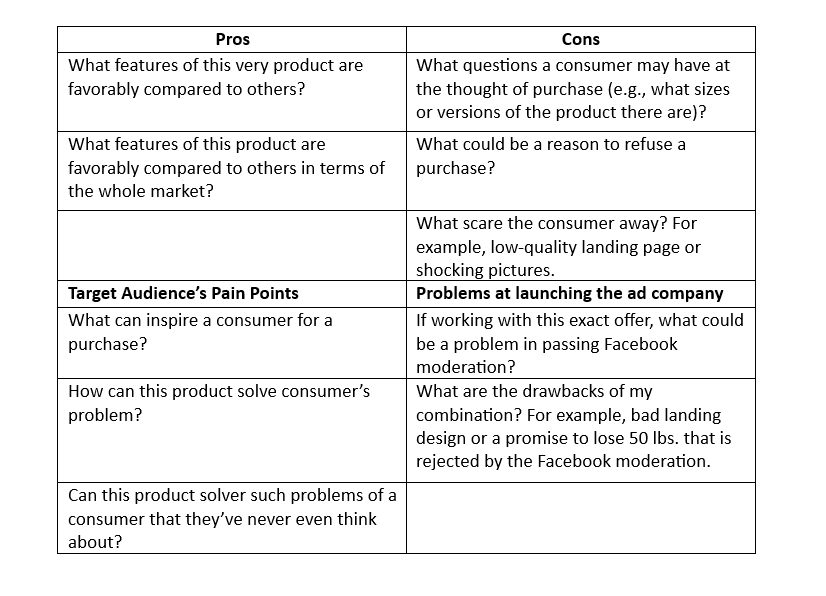
After this comparison, webmaster will have a whole pool of data and ideas for creating converting and honest creatives tailored to the target audience without clichés.
How to test an offer
Earlier, we discussed how to analyze an offer. However, it’s not guaranteed that the initial assumption and the creative based on it will be the only correct and converting solution. Therefore, many webmasters test several approaches at once, then look at the results, and proceed with the most promising combination. More details on this below.
Ad campaign structure
Let’s start with how the ideal structure of the campaign should look. It will depend on the offer itself, the goal, and the budget, but it typically looks as follows:

As can be noticed above, the campaign is the top part of the structure and consists of ad sets and ads. At this stage, the webmaster needs to set the goal and enable campaign-level optimization. Let’s break down each component in more detail.
Ad sets
When creating an ad set, the webmaster should configure event optimization, targeting, placement, and bidding type. Here are a couple of recommendations in this regard:
- It’s better to target a broad audience, limiting it only by gender, age, and location;
- There’s no need to set interests, as practice shows they often don’t work;
- It’s also not recommended to use the placement of feeds, Facebook stories, and automatic placement selection on smartphones, as with interests, it will be a wasteful budget drain.
Advertisement
In one Facebook ad set, you can add up to 6 ads with different creatives, text, and links. Note that the platform operates on an auction principle, so it’s essential not only to duplicate creatives and ad sets within one account but also to share them with other accounts because the results can vary significantly due to auction dynamics.
Also, if campaign-level optimization is not used, you can disable ad sets. But if it’s enabled, it’s better not to do that. In such a case, it’s advisable to either pause the entire campaign and launch a new one or stop the entire ad set. Otherwise, you can disrupt the auction, which happens quite often.
A few more words about campaign optimization. If the initial results are positive, it’s advisable to refrain from making changes during the learning phase. Instead, focus on:
- Critical cost per lead (payout * (approval rate / 100) / (ROI / 100+1));
- Critical cost per click (cost per lead multiplied by the expected conversion rate);
- Critical CTR (CPM / 1000 * CPC);
- And critical conversion rate (estimated cost per click / estimated cost per lead).
By specifying the reward amount and offer approval rate, you can determine these critical metrics that you should not exceed during the testing phase. If the numbers exceed these values, you can confidently pause the campaign. The result will remain the same even after a day. Some webmasters have a different approach and continue traffic for two days. This approach is also valid but may not be suitable for beginners with a limited budget.
By the way, we have analyzed how traffic is driven through Twitter in three niches. Read more about it in that article!
How much testing is needed to get reliable results
This depends on both the offer and the GEO of the campaign. Typically, testing takes up to 2 days with a budget of up to 2 times the cost per conversion (for one theory). On average, to make a final decision about the reliability of the selected events, you’ll need up to 15 actions and 3 conversions.
How to optimize an ad campaign
If the campaign is close to critical values, it doesn’t mean you should forget about it. If you identify the reasons why an ad didn’t perform well, you can try optimizing by:
- Disabling placements that aren’t yielding results;
- Restricting targeting to the purchasing audience;
- Increasing the CTR of ads with good conversions and disabling those with critical CTR and conversion rates;
- Duplicating ad sets with positive results;
- Increasing the budget for effective ad sets.
Different strategies for audience targeting
Audience targeting is fundamental in modern marketing to effectively target specific groups of people with relevant messages. Here are some common strategies and their advantages and disadvantages:
Interests:
Advantages: It is based on users’ interests and preferences, which can result in more accurate and relevant targeting. You can reach people who are more likely to be interested in a specific product or service.
Disadvantages: It can be difficult to determine users’ interests accurately, especially if they don’t have a clear online activity related to those interests. In addition, interests can change over time, which requires dynamic segmentation.
Geography:
Advantages: It divides the audience based on their geographical location.This can be useful for companies that have a limited reach or that offer specific products or services to certain regions. Disadvantages: It can overlook the differences within a geographical region and not take into account other important factors such as culture or language. In addition, not all companies benefit from geographical targeting.
Demographics:
Advantages: It divides the audience into groups based on demographic characteristics such as age, gender, income, education, etc. It is easy to understand and apply, and can provide a solid basis for segmentation.
Disadvantages: It can be too generalized and not take into account individual differences within a demographic group. In addition, people within the same demographic group may have very different interests and behaviors.
Each strategy has its own pros and cons, and the right combination of these strategies will depend on a company’s specific marketing objectives and the characteristics of its target audience.
Examples of successful Facebook Ad campaigns
When it comes down to selecting an adequate Facebook ad strategy, it is crucial to choose the right audience. Facebook ads work because of the number of users on the platform and the high level of audience targeting. For example, if we take beauty product targeting, a marketer can target people who follow beauty bloggers and influencers which means that they are interested in taking care of their appearance. You can promote skincare products, in particular, by using high-quality visuals of the product and testimonials from beauty influencers. Fitness is another example of successful Facebook targeting as it is getting more and more popular nowdays. Your ads can showcase athletes wearing fitness watches and emphasize features relevant to their target audience like heart rate monitoring or GPS tracking.



